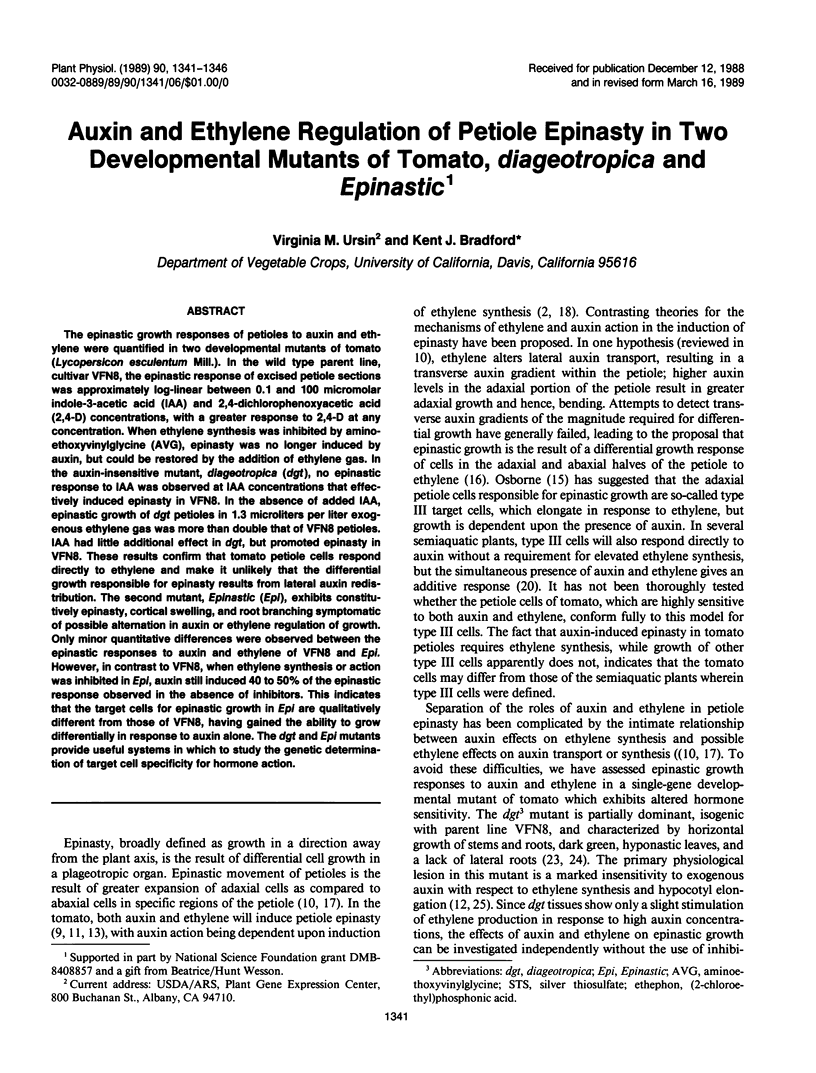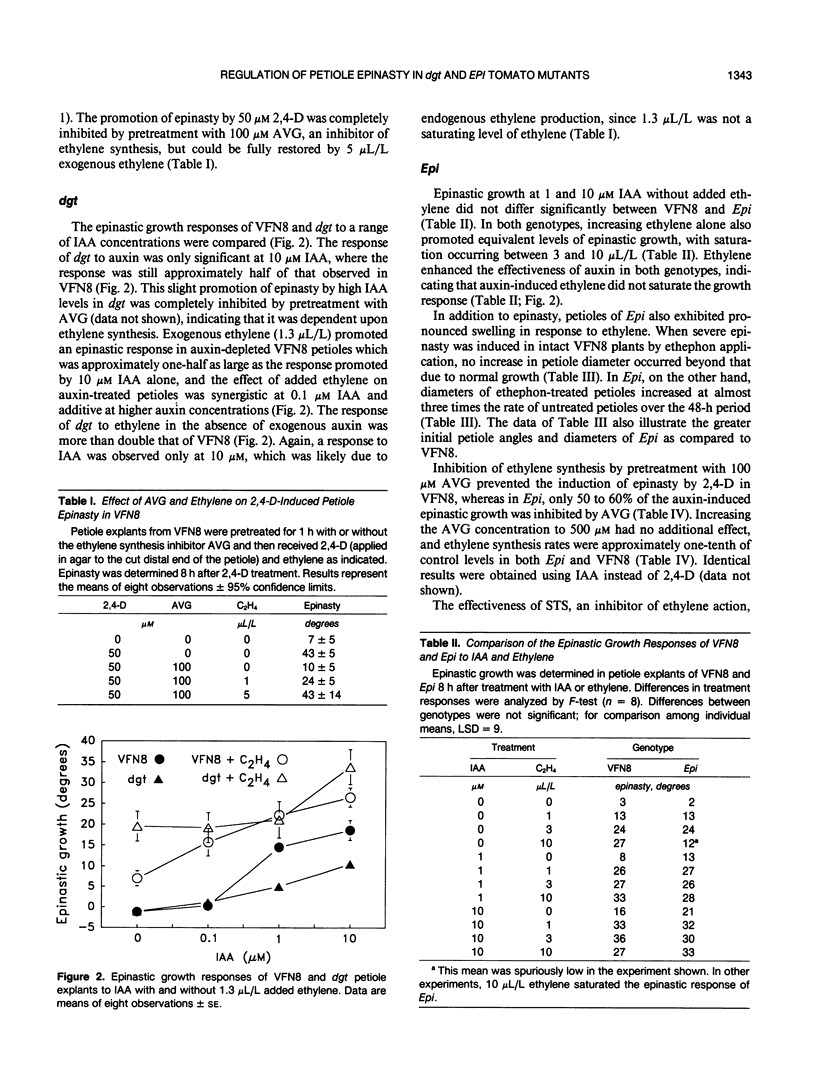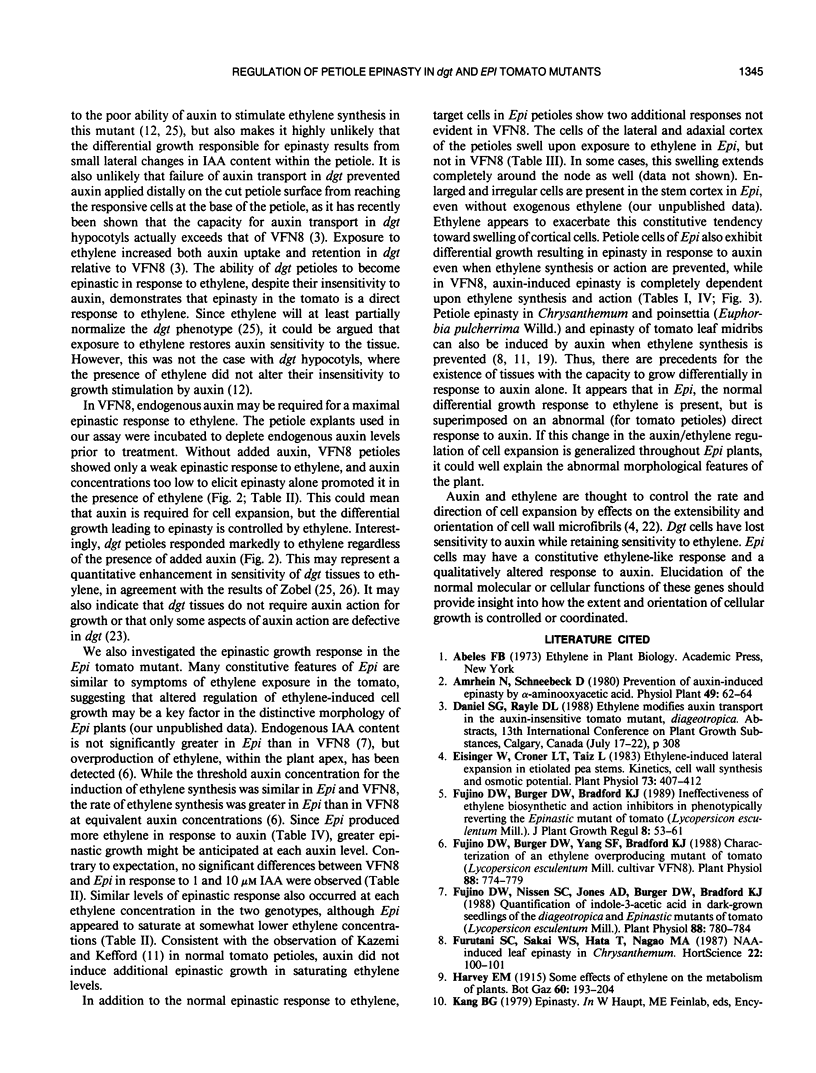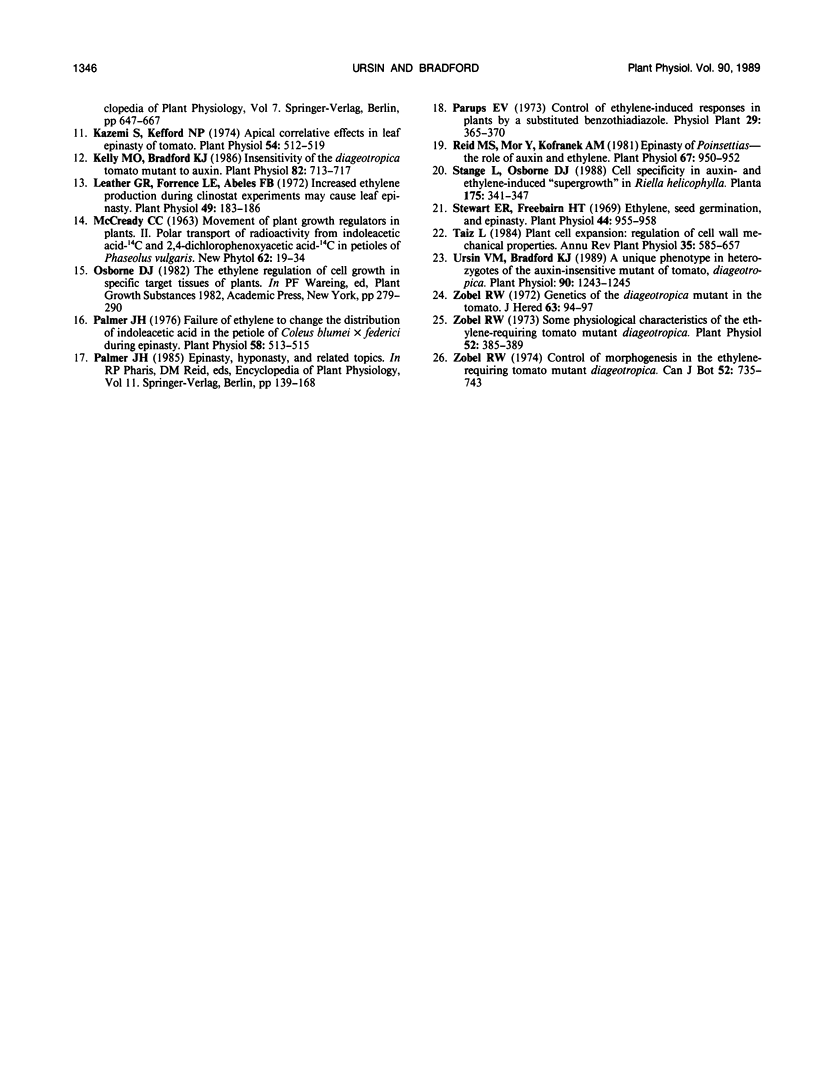Abstract
The epinastic growth responses of petioles to auxin and ethylene were quantified in two developmental mutants of tomato (Lycopersicon esculentum Mill.). In the wild type parent line, cultivar VFN8, the epinastic response of excised petiole sections was approximately log-linear between 0.1 and 100 micromolar indole-3-acetic acid (IAA) and 2,4-dichlorophenoxyacetic acid (2,4-D) concentrations, with a greater response to 2,4-D at any concentration. When ethylene synthesis was inhibited by aminoethoxyvinylglycine (AVG), epinasty was no longer induced by auxin, but could be restored by the addition of ethylene gas. In the auxin-insensitive mutant, diageotropica (dgt), no epinastic response to IAA was observed at IAA concentrations that effectively induced epinasty in VFN8. In the absence of added IAA, epinastic growth of dgt petioles in 1.3 microliters per liter exogenous ethylene gas was more than double that of VFN8 petioles. IAA had little additional effect in dgt, but promoted epinasty in VFN8. These results confirm that tomato petiole cells respond directly to ethylene and make it unlikely that the differential growth responsible for epinasty results from lateral auxin redistribution. The second mutant, Epinastic (Epi), exhibits constitutively epinasty, cortical swelling, and root branching symptomatic of possible alternation in auxin or ethylene regulation of growth. Only minor quantitative differences were observed between the epinastic responses to auxin and ethylene of VFN8 and Epi. However, in contrast to VFN8, when ethylene synthesis or action was inhibited in Epi, auxin still induced 40 to 50% of the epinastic response observed in the absence of inhibitors. This indicates that the target cells for epinastic growth in Epi are qualitatively different from those of VFN8, having gained the ability to grow differentially in response to auxin alone. The dgt and Epi mutants provide useful systems in which to study the genetic determination of target cell specificity for hormone action.
Full text
PDF





Selected References
These references are in PubMed. This may not be the complete list of references from this article.
- Eisinger W., Croner L. J., Taiz L. Ethylene-induced lateral expansion in etiolated pea stems : kinetics, cell wall synthesis, and osmotic potential. Plant Physiol. 1983 Oct;73(2):407–412. doi: 10.1104/pp.73.2.407. [DOI] [PMC free article] [PubMed] [Google Scholar]
- Fujino D. W., Burger D. W., Yang S. F., Bradford K. J. Characterization of an Ethylene Overproducing Mutant of Tomato (Lycopersicon esculentum Mill. Cultivar VFN8). Plant Physiol. 1988 Nov;88(3):774–779. doi: 10.1104/pp.88.3.774. [DOI] [PMC free article] [PubMed] [Google Scholar]
- Fujino D. W., Nissen S. J., Jones A. D., Burger D. W., Bradford K. J. Quantification of Indole-3-Acetic Acid in Dark-Grown Seedlings of the Diageotropica and Epinastic Mutants of Tomato (Lycopersicon esculentum Mill.). Plant Physiol. 1988 Nov;88(3):780–784. doi: 10.1104/pp.88.3.780. [DOI] [PMC free article] [PubMed] [Google Scholar]
- Kazemi S., Kefford N. P. Apical correlative effects in leaf epinasty of tomato. Plant Physiol. 1974 Oct;54(4):512–519. doi: 10.1104/pp.54.4.512. [DOI] [PMC free article] [PubMed] [Google Scholar]
- Kelly M. O., Bradford K. J. Insensitivity of the diageotropica tomato mutant to auxin. Plant Physiol. 1986 Nov;82(3):713–717. doi: 10.1104/pp.82.3.713. [DOI] [PMC free article] [PubMed] [Google Scholar]
- Leather G. R., Forrence L. E. Increased Ethylene Production during Clinostat Experiments May Cause Leaf Epinasty. Plant Physiol. 1972 Feb;49(2):183–186. doi: 10.1104/pp.49.2.183. [DOI] [PMC free article] [PubMed] [Google Scholar]
- Palmer J. H. Failure of Ethylene to Change the Distribution of Indoleacetic Acid in the Petiole of Coleus blumei X frederici during Epinasty. Plant Physiol. 1976 Oct;58(4):513–515. doi: 10.1104/pp.58.4.513. [DOI] [PMC free article] [PubMed] [Google Scholar]
- Reid M. S., Mor Y., Kofranek A. M. Epinasty of Poinsettias-the Role of Auxin and Ethylene. Plant Physiol. 1981 May;67(5):950–952. doi: 10.1104/pp.67.5.950. [DOI] [PMC free article] [PubMed] [Google Scholar]
- Stewart E. R., Freebairn H. T. Ethylene, seed germination, and epinasty. Plant Physiol. 1969 Jul;44(7):955–958. doi: 10.1104/pp.44.7.955. [DOI] [PMC free article] [PubMed] [Google Scholar]
- Ursin V. M., Bradford K. J. A Unique Phenotype in Heterozygotes of the Auxin-Insensitive Mutant of Tomato, diageotropica. Plant Physiol. 1989 Aug;90(4):1243–1245. doi: 10.1104/pp.90.4.1243. [DOI] [PMC free article] [PubMed] [Google Scholar]
- Zobel R. W. Some Physiological Characteristics of the Ethylene-requiring Tomato Mutant Diageotropica. Plant Physiol. 1973 Oct;52(4):385–389. doi: 10.1104/pp.52.4.385. [DOI] [PMC free article] [PubMed] [Google Scholar]


